For most of us, backyard habitats are somewhat limited. What habitats we provide wildlife will depend on how we have landscaped our yard. However, we all provide some form of habitat. There are lot of things that invertebrates will find useful. Birds and squirrels tend to find places they can use. Many of us have flower gardens that attract many kinds of creatures.
Today is one that some of us may or may not have… logs.
This can be a log pile or, maybe just some downed limbs in a portion of the yard where we don’t go often.
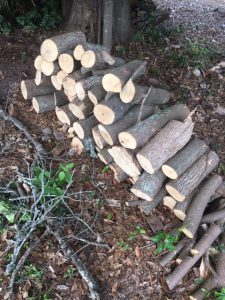
When I was in college, we made many field trips into the woods and wetlands studying wildlife with my professor. One of his favorite activities was to roll over logs. We always found something cool there. He was primarily interested in salamanders, but there were always other creatures there to observe and learn about. OH! And there was one other lesson he taught us. Always… Always place the log back in its original spot.
There was a reason for this. The logs, like the leaves we mentioned in lesson 2, sort of break down (“cook”) over time and form a moist, humid environmental where the wood is beginning to rot, and creatures can use it. So, you want to place the log in the exact same place, in the exact same orientation, to continue this process of succession.
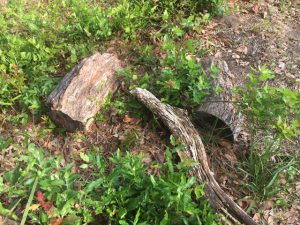
At first there is very little under the log other than smashed grass blades. But there are creatures that can utilize wood at this stage, and they move in – they are called the pioneer community. Eventually the pioneer community will begin the break the wood down. There are new cavities formed in the heart of the wood where new creatures can live. The wood is softer now that some other creatures can utilize it – we are now in the intermediate community. The process continues until the log is basically rotten and falls apart in your hand. At this stage there are numerous creatures who use this habitat for space and food, and others in your yard who use it to look for things to eat. We are now at the climax community.
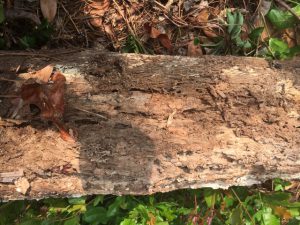
It takes a long time to go from the primary to the climax community. For many who have logs in their yards it is in the early stages, and there may be little wildlife there. Most people will stack a pile of cut firewood to “season” it. Newly cut limbs are what we call “green” and will not burn well. So, we stack the wood and let it sit for a while. Unknown to us, the process of succession has begun. Actually, the salamander was believed to be a mythical creature by the Romans. They noticed when you placed a “seasoned” log on a fire salamanders would run out. It was believed they could tolerate – or were “born of fire”. This makes sense. Creatures living in a seasoned log (and there are many) will certainly come running out if you place it on a fire.
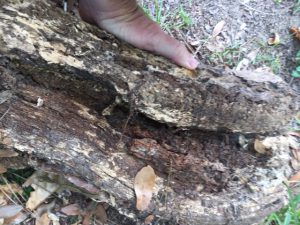
Over the years of looking under logs in my yard I have found primarily invertebrates. These would include millipedes, centipedes, grubs of different insects, spiders, earwigs (with their pincers on their tail), pill bugs (roly-polies), slimy slugs, and… cockroaches – always cockroaches.
For vertebrates I have found the Brahminy Blind Snake, skinks, and sometimes the southern toad. I think one of the coolest creatures I have found is the glass lizard. The glass lizard looks like a snake – it has no legs. But it is not a snake at all but a lizard.
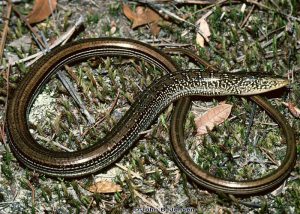
Photo: John Jensen UF
Why is that?
Well, snakes do not have eyelids and do not have an exterior ear opening – lizards do, and glass lizards do – so it is a legless lizard. It is called a “glass” lizard because many lizards have the habit of dropping their tails when you pick them up. This is so the predator will consume the broken tip of the tail and leave them alone. Glass lizards will do this, and it seems you have broken them in half when they do – like they are made of glass. They are really cool and common in our yards. But they need really dense vegetation and logs that have been “cooking” for a while. We recently cleared the area where we have a couple of logs “cooking” for wildlife and they apparently did not like this – so have moved on somewhere else. You will know one when you see one. They are about 10” long, green on top with some yellow/white/black speckles and the belly is yellow. Google these later today and learn more about them – see what they look like. Again, they are very cool.
I am not sure you have logs in your yard, but maybe there is a wooded area near your home where you could find some. Of course, we need to be mindful of the social distancing that is going on. A report last night suggested it may be working, so we want to keep doing it.
ACITIVITY
– Let’s find either logs that have been lying on the ground, or a stack of wood for fires later this year.
– Carefully roll the log in one direction so you can see beneath.
– Is the log still solid? If so, are there any creatures using it at this stage?
– Has the log begun to rot? If so, what creatures are running around or within the cavity of the log? Remember some creatures bite and spiders can be painful.
– ALWAYS roll the log back into the exact same position when you are done exploring.
– OH! And remember to google the Glass Lizard and see what they look like.
LET’S GET OUTSIDE AND EXPLORE – ENJOY THE DAY – AND REMEMBER TO BE SAFE
 0
0
